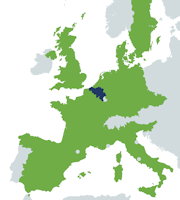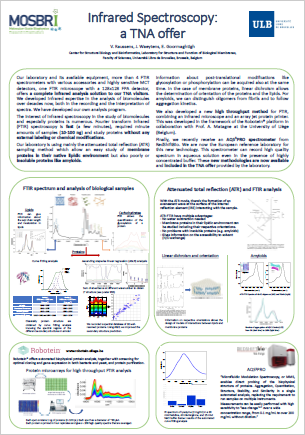3) ULB – Centre for Structural Biology and Bioinformatics, Université Libre de Bruxelles
Location: Brussels, Belgium
Web-site(s):
MOSBRI reference site for the following techniques:
FTIR: Fourier Transform Infrared Spectroscopy

Partner description
The infrastructure is located in the Centre for Structural Biology and Bioinformatics of the Université Libre de Bruxelles (ULB), in Brussels.
ULB have particular expertise in membrane proteins and amyloid or aggregated proteins, by use of FTIR spectroscopy and imaging. FTIR allows investigations of complex samples which include lipids, proteins, nucleic acids and carbohydrates, including samples which are mixtures of these components. For proteins ULB also have expertise in secondary structure analysis, both via peak fitting but also via a much more straightforward linear regression method developed at ULB. It is noteworthy that this method is independent of sample concentration, such that samples with unknown concentrations may be fully analyzed. When compared to other secondary structure methods like circular dichroism (CD), that have high sensitivity to helical structure, then FTIR is more sensitive to beta structures, hence FTIR and CD may be regarded as complementary methods. Should you wish to take advantage of this synergy between FTIR and CD spectroscopy, MOSBRI offers transnational access to both methods via a single proposal for access to ULB and the MOSBRI partner AU-SRCD.
The measurement of complex samples like membrane proteins in liposomes, amyloids or aggregated samples is eased by use of the reflection technique ATR (attenuated total reflectance) on a high quality diamond crystal providing excellent signal to noise spectra on as little as 10-100 ng of protein sample. See the “ULB: Sample requirements” page for more detailed information. The ATR method has multiple advantages: as the samples are dried on the ATR crystal there is no need for water subtraction, membrane proteins are measured in their lipidic environment and may be analyzed for their orientation, and sample solubility is not a requirement.
Additionally ULB offers access to high throughout analysis of proteins via a combination of microarrays with state-of-the-art FTIR imaging as a unique tool. Here as little as 100 pL of samples down to 0.25 mg/mL concentration are placed via a robotic microarrayer in spots less than 100 µm in diameter. Up to 100 spectra are averaged for each sample spot, and this allows FTIR spectra to be recorded on samples that are (less than) a monolayer of protein in thickness.
Instruments / methodologies offered through TNA
The main pieces of equipment are:
- Microarrayer: protein microarrays (up to 4,000 spots/cm2) are produced by an Arrayjet Marathon Microarrayer (ArrayJet, Roslin, UK). Temperature, relative humidity and HEPA air filtration control provided by a Jetmosphere TM Environmental Control System (ArrayJet, Roslin, UK).
- Pipetting robot: Pipetting robot Freedom EVO 150 (AirLiha 8) robotic unit from TECAN. Used to prepare 384 well-paltes to feed the microarrayer.
- FTIR imaging: data are collected using an Agilent 128 x 128 Mercury Cadmium Telluride (MCT) Focal Plane Array (FPA) detector for mid-IR imaging. 15x and 4x objectives + high magnification.
- Standard FTIR spectroscopy and accessories: five FTIR spectrometers with MCT detectors, ATR, variable angle ATR, polarizers, high throughput 96-well plates transmission FTIR spectroscopy.
Access modality: Typically 3-5 days are sufficient for an exhaustive study of a few samples. Both physical and remote access is provided.
Sample requirements
Full details of the sample requirements for the techniques offered at this TNA site can be found here.

